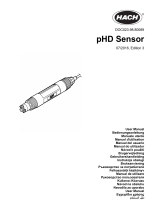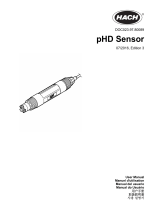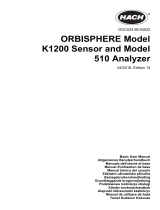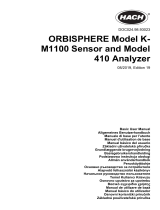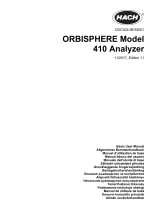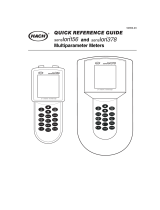Page is loading ...

Instruction Manual
LIQ-MAN-1056
Rev. K
April 2017
Rosemount
™
1056
Dual-Input Intelligent Analyzer

Essential Instructions
READ THIS PAGE BEFORE PROCEEDING!
Your instrument purchase from Emerson is one of
the finest available for your particular application.
These instruments have been designed, and tested
to meet many national and international standards.
Experience indicates that its performance is directly
related to the quality of the installation and knowl-
edge of the user in operating and maintaining the
instrument. To ensure their continued operation to
the design specifications, personnel should read this
manual thoroughly before proceeding with installa-
tion, commissioning, operation, and maintenance of
this instrument. If this equipment is used in a man-
ner not specified by the manufacturer, the protection
provided by it against hazards may be impaired.
• Failure to follow the proper instructions may
cause any one of the following situations to
occur: Loss of life; personal injury; property dam-
age; damage to this instrument; and warranty
invalidation.
• Ensure that you have received the correct model
and options from your purchase order. Verify that
this manual covers your model and options. If
not, call 1-800-854-8257 or 949-757-8500 to
request correct manual.
• For clarification of instructions, contact your
Rosemount representative.
• Follow all warnings, cautions, and instructions
marked on and supplied with the product.
• Use only qualified personnel to install, operate,
update, program and maintain the product.
• Educate your personnel in the proper installation,
operation, and maintenance of the product.
• Install equipment as specified in the Installation
section of this manual. Follow appropriate local
and national codes. Only connect the product to
electrical and pressure sources specified in this
manual.
• Use only factory documented components for
repair. Tampering or unauthorized substitution of
parts and procedures can affect the performance
and cause unsafe operation of your process.
• All equipment doors must be closed and protec-
tive covers must be in place unless qualified per-
sonnel are performing maintenance.
Equipment protected throughout by double insulation.
• Installation and servicing of this product may expose personel
to dangerous voltages.
• Main power wired to separate power source must be
disconnected before servicing.
• Do not operate or energize instrument with case open!
• Signal wiring connected in this box must be rated at least
240 V.
• Non-metallic cable strain reliefs do not provide grounding
between conduit connections! Use grounding type bushings
and jumper wires.
• Unused cable conduit entries must be securely sealed by
non-flammable closures to provide enclosure integrity in
compliance with personal safety and environmental protection
requirements. Unused conduit openings must be sealed with
NEMA 4X or IP65 conduit plugs to maintain the ingress
protection rating (NEMA 4X).
• Electrical installation must be in accordance with the National
Electrical Code (ANSI/NFPA-70) and/or any other applicable
national or local codes.
• Operate only with front panel fastened and in place.
• Safety and performance require that this instrument be
connected and properly grounded through a three-wire
power source.
• Proper use and configuration is the responsibility of the
user.
This product generates, uses, and can radiate radio frequency
energy and thus can cause radio communication interference.
Improper installation, or operation, may increase such interfer-
ence. As temporarily permitted by regulation, this unit has not
been tested for compliance within the limits of Class A comput-
ing devices, pursuant to Subpart J of Part 15, of FCC Rules,
which are designed to provide reasonable protection against
such interference. Operation of this equipment in a residential
area may cause interference, in which case the user at his own
expense, will be required to take whatever measures may be
required to correct the interference.
This product is not intended for use in the light industrial,
residential or commercial environments per the instru-
ment’s certification to EN50081-2.
CAUTION
WARNING
RISK OF ELECTRICAL SHOCK
CAUTION

Quick Start Guide
Rosemount 1056 Dual-Input Intelligent Analyzer
1. Refer to Section 2.0 for mechanical installation instructions.
2. Wire sensor(s) to the signal boards. See Section 3.0 for wiring instructions. Refer to the sensor instruction
sheet for additional details. Make current output, alarm relay and power connections.
3. Once connections are secured and verified, apply power to the analyzer.
4. When the analyzer is powered up for the first time, Quick Start screens appear. Quick Start operating tips
are as follows:
a. A backlit field shows the position of the cursor.
b. To move the cursor left or right, use the keys to the left or right of the ENTER key. To scroll up or down
or to increase or decrease the value of a digit use the keys above and below the ENTER key . Use the
left or right keys to move the decimal point.
c. Press ENTER to store a setting. Press EXIT to leave without storing changes. Pressing EXIT during Quick
Start returns the display to the initial start-up screen (select language).
5. Complete the steps as shown in the Quick Start Guide flow diagram, Fig. A on the following page.
6. After the last step, the main display appears. The outputs are assigned to default values.
7. To change output, and temperature-related settings, go to the main menu and choose Program. Follow the
prompts. For a general guide to the Program menu, see the Quick Reference Guide, Fig.B.
8. To return the analyzer to the default settings, choose Reset Analyzer under the Program menu.
Electrical installation must be in accordance with
the National Electrical Code (ANSI/NFPA-70)
and/or any other applicable national or local codes.
WARNING
RISK OF ELECTRICAL SHOCK

Quick Start Guide
Figure A. Quick Start Guide

Quick Reference Guide
Figure B. Model 1056 Menu Tree

This manual contains instructions for installation and operation of the Rosemount 1056 Dual Input
Intelligent Analyzer. The following list provides notes concerning all revisions of this document.
Rev. Level Date Notes
A 01/07 This is the initial release of the product manual. The manual has been reformatted to reflect the
Emerson documentation style and updated to reflect any changes in the product offering.
B 2/07 Added CE mark to p.2. Replaced Quick Start Fig A.
C 9/07 Revised Sections 1,3,5,6, and 7. Added new measurements and features - Turbidity, Flow, Current
Input, Alarm relays and 4-electrode conductivity.
D 11/07 Added 24VDC power supply to Sec. 3.4. Added CSA and FM agency approvals for option codes
-01, 20, 21, 22, 24, 25, 26, 30, 31, 32, 34, 35, 36 and 38.
E 05/08 Add HART and Profibus DP digital communication to Section 1 specifications.
F 08/08 Updates
G 09/08 FM and CSA agency approval, Class 1, Div 2. for 24 VDC and AC switching power supplies.
H 04/10 Update DNV logo and company name
I 03/12 Update addresses - mail and web
J 05/14 Update enclosure information
K 04/17 Updated Address and Emerson Logo. Also, updated CE declarations.
About This Document

MODEL 1056
DUAL INPUT INTELLIGENT ANALYZER
TABLE OF CONTENTS
QUICK START GUIDE
QUICK REFERENCE GUIDE
TABLE OF CONTENTS
Section Title Page
1.0 DESCRIPTION AND SPECIFICATIONS ................................................................ 1
2.0 INSTALLATION ....................................................................................................... 11
2.1 Unpacking and Inspection........................................................................................ 11
2.2 Installation................................................................................................................ 11
3.0 WIRING.................................................................................................................... 21
3.1 General .................................................................................................................... 21
3.2 Preparing Conduit Openings.................................................................................... 21
3.3 Preparing Sensor Cable .......................................................................................... 22
3.4 Power, Output, Alarms and Sensor Connections..................................................... 22
4.0 DISPLAY AND OPERATION ................................................................................... 29
4.1 User Interface .......................................................................................................... 29
4.2 Instrument Keypad................................................................................................... 29
4.3 Main Display ............................................................................................................ 30
4.4 Menu System ........................................................................................................... 31
5.0 PROGRAMMING – BASICS ................................................................................... 33
5.1 General .................................................................................................................... 33
5.2 Changing the StartUp Settings ................................................................................ 33
5.3 Choosing Temperature units and Automatic/Manual Temperature Compensation .. 34
5.4 Configuring and Ranging the Current Outputs......................................................... 34
5.5 Setting a Security Code ........................................................................................... 36
5.6 Security Access........................................................................................................ 37
5.7 Using Hold ............................................................................................................... 37
5.8 Resetting Factory Defaults – Reset Analyzer .......................................................... 38
5.9 Alarm Relays............................................................................................................ 39
6.0 PROGRAMMING - MEASUREMENTS ................................................................... 43
6.1 Programming Measurements – Introduction ........................................................... 43
6.2 pH ............................................................................................................................ 44
6.3 ORP ......................................................................................................................... 45
6.4 Contacting Conductivity .......................................................................................... 47
6.5 Toroidal Conductivity................................................................................................ 50
6.6 Chlorine.................................................................................................................... 53
6.6.1 Free Chlorine .................................................................................................. 53
6.6.2 Total Chlorine ................................................................................................. 55
6.6.3 Monochloramine ............................................................................................ 56
6.6.4 pH-independent Free Chlorine ....................................................................... 57
6.7 Oxygen..................................................................................................................... 59
6.8 Ozone ...................................................................................................................... 60
i
Instruction Manual
LIQ-MAN-1056
Table of Contents
April 2017

ii
Instruction Manual
LIQ-MAN-1056
Table of Contents
April 2017
TABLE OF CONTENTS CONT’D
6.9 Turbidity ................................................................................................................... 62
6.10 Flow ......................................................................................................................... 65
6.11 Current Input ............................................................................................................ 66
7.0 CALIBRATION ...................................................................................................... 77
7.1 Calibration – Introduction ......................................................................................... 77
7.2 pH Calibration .......................................................................................................... 78
7.3 ORP Calibration ....................................................................................................... 80
7.4 Contacting Conductivity Calibration ......................................................................... 81
7.5 Toroidal Conductivity Calibration ............................................................................. 84
7.6 Chlorine Calibration ................................................................................................. 86
7.6.1 Free Chlorine .................................................................................................. 86
7.6.2 Total Chlorine .................................................................................................. 88
7.6.3 Monochloramine ............................................................................................. 90
7.6.4 pH-Independent Free Chlorine ....................................................................... 92
7.7 Oxygen Calibration .................................................................................................. 94
7.8 Ozone Calibration .................................................................................................... 97
7.9 Temperature Calibration........................................................................................... 99
7.10 Turbidity ................................................................................................................... 100
7.11 Pulse Flow ............................................................................................................... 102
8.0 RETURN OF MATERIAL ........................................................................................ 115
Warranty................................................................................................................... 115
EC DECLARATION OF CONFORMITY.................................................................. 117

Section 1.0
Description and Specifications
1
1.1 Features and Applications
The 1056 dual-input analyzer offers single or dual sen-
sor input with an unrestricted choice of dual measure-
ments. This multi-parameter instrument offers a wide
range of measurement choices supporting most indus-
trial, commercial, and municipal applications. The
modular design allows signal input boards to be field
replaced making configuration changes easy.
Conveniently, live process values are always displayed
during programming and calibration routines.
Quick Start Programming: Exclusive Quick Start
screens appear the first time the 1056 is powered.
The instrument auto-recognizes each measurement
board and prompts the user to configure each sensor
loop in a few quick steps for immediate deployment.
Digital Communications: HART and Profibus DP dig-
ital communications are available. The 1056 HART
units communicate with the Model 375 HART
®
hand-
held communicator and HART hosts, such as AMS
Intelligent Device Manager. Model 1056 Profibus units
are fully compatible with Profibus DP networks and
Class 1 or Class 2 masters. HART and Profibus DP
configured units will support any single or dual
measurement configuration of Model 1056.
Menus: Menu screens for calibrating and programming
are simple and intuitive. Plain language prompts and
help screens guide the user through these procedures.
Dual Sensor Input and Output: The 1056 accepts
single or dual sensor input. Standard 0/4-20 mA
current outputs can be programmed to corre-
spond to any measurement or temperature.
Enclosure: The instrument fits standard ½ DIN panel
cutouts. The versatile enclosure design supports
panel-mount, pipe-mount, and surface/wall-mount
installations.
Isolated Inputs: Inputs are isolated from other signal
sources and earth ground. This ensures clean signal
inputs for single and dual input configurations. For
dual input configurations, isolation allows any combi-
nation of measurements and signal inputs without
cross-talk or signal interference.
Temperature: Most measurements require tempera-
ture compensation. The 1056 will automatically recog-
nize Pt100, Pt1000 or 22k NTC RTDs built into the
sensor.
Security Access Codes: Two levels of security access
are available. Program one access code for routine cal-
ibration and hold of current outputs; program another
access code for all menus and functions.
• MULTI-PARAMETER INSTRUMENT – single or dual input. Choose from pH/ORP/ISE,
Resistivity/Conductivity, % Concentration, Chlorine, Oxygen, Ozone, Temperature, Turbidity, Flow,
and 4-20mA Current Input.
• LARGE DISPLAY – large easy-to-read process measurements.
• EASY TO INSTALL – modular boards, removable connectors, easy to wire power, sensors, and outputs.
• INTUITIVE MENU SCREENS with advanced diagnostics and help screens.
• SEVEN LANGUAGES included: English, French, German, Italian, Spanish, Portuguese, and Chinese.
• HART
®
AND PROFIBUS
®
DP Digital Communications options
Instruction Manual
LIQ-MAN-1056
Section 1.0: Description and Specification
April 2017

2
Diagnostics: The analyzer continuously monitors
itself and the sensor(s) for problematic conditions.
The display flashes Fault and/or Warning when these
conditions occur.
Display: The high-contrast LCD provides live meas-
urement readouts in large digits and shows up to four
additional process variables or diagnostic parame-
ters. The display is back-lit and the format can be cus-
tomized to meet user requirements.
LOCAL LANGUAGES:
Rosemount extends its worldwide reach by offering
seven local languages – English, French, German,
Italian, Spanish, Portuguese, and Chinese. Every unit
includes user programming menus; calibration routines;
faults and warnings; and user help screens in all
seven languages. The displayed language can be
easily set and changed using the menus.
CURRENT OUTPUTS: Two 4-20 mA or 0-20 mA current
outputs are electrically isolated. Outputs are fully scalable
and can be programmed to linear or logarithmic
modes. Output dampening can be enabled with time
constants from 0 to 999 seconds. Output 1 includes
digital signal 4-20 mA superimposed HART (option -HT
only)
Special Measurements: The Model 1056 offers
measuring capabilities for many applications.
l
Single or Dual Turbidity: Ideal in municipal appli-
cations for measurement of low-NTU filtered drinking
water. Must be used with Clarity II sensor, sensor cable
and debubbler.
l
4-Electrode Conductivity:
The 1056 is compatible with Rosemount 4-elec-
trode Model 410VP in the PUR-SENSE
family of conductivity sensors. This sensor supports
a wide array of applications and is capable of measuring
a large range of conductivity with one geometric
configuration. Wired to the 1056, this sensor can
measure 2µS/cm to 300mS/cm with an accuracy of 4%
of reading throughout the entire range.
l
4-20mA Current Input: Accepts any analog current
input from an external device for temperature compen-
sation of measurements and atmospheric pressure
input for partial pressure correction of oxygen.
l
Selective Ions: The analyzer is able to measure
ammonia and fluoride using commercially available
ion-selective electrodes. All analyzers with installed pH
boards can be programmed to measure selective ions.
l
pH Independent Free Chlorine: With Rosemount
498Cl-01 sensor, the analyzer is able to measure free
chlorine with automatic correction for process pH with-
out the need for a pH sensor.
l
Inferential pH: The analyzer is able to derive and
display inferred pH (pHCalc) using two contacting con-
ductivity signal boards and the appropriate contacting
conductivity sensors. This method will calculate the
pH of condensate and boiler water from conductivity
and cation conductivity measurements.
l
Differential Conductivity: Dual input conductivity
configurations can measure differential conductivity.
The analyzer can be programmed to display dual
conductivity as ratio, % rejection, or % passage.
S1: 1.234µS/cm 25.0ºC
S2: 12.34pH 25.0ºC
Diagnostics
Faults
Warnings
Sensor 1
Sensor 2
Out 1: 12.05 mA
Out 2: 12.05 mA
1056-01-20-32-HT
Instr SW VER: 2.12
AC Freq. Used: 60Hz
Information about
each condition
is quickly accessible
by pressing DIAG on
the keypad. User
help screens are
displayed for most
fault and warning
conditions to assist in
troubleshooting.
Model T1056
Clarity
®
II
Turbidimeter
System
Instruction Manual
LIQ-MAN-1056
Section 1.0: Description and Specification
April 2017

3
1.2 Specifications - General
Enclosure: Polycarbonate. Type 4X, IP65.
Note: To ensure a water-tight seal, tighten all four front panel
screws to 6 in-lbs of torque
Dimensions: Overall 155 x 155 x 131mm (6.10 x 6.10 x 5.15
in.). Cutout: 1/2 DIN 139mm x 139mm (5.45 x 5.45 in.)
Conduit Openings: Accepts 1/2” or PG13.5 conduit fittings
Display: Monochromatic graphic liquid crystal display.
128 x 96 pixel display resolution. Backlit. Active display
area: 58 x 78mm (2.3 x 3.0 in.).
Ambient Temperature and Humidity: 0 to 55°C
(32 to 131°F). Turbidity only: 0 to 50°C (32 to 122°F),
RH 5 to 95% (non-condensing)
Storage Temperature Effect: -20 to 60 ºC (-4 to 140 °F)
Power: Code -01: 115/230 VAC ±15%, 50/60 Hz. 10W.
Code -02: 20 to 30 VDC. 15 W.
Code -03: 85 to 265 VAC, 47.5 to 65.0 Hz,
switching. 15 W.
Note: Code -02 and -03 power supplies include four
programmable relays
Equipment protected by double insulation
Alarms relays*: Four alarm relays for process measure-
ment(s) or temperature. Any relay can be configured as a
fault alarm instead of a process alarm. Each relay can be
configured independently and each can be programmed with
interval timer settings.
Relays: Form C, SPDT, epoxy sealed
Inductive load: 1/8 HP motor (max.), 120/240 VAC
*Relays only available with 02 power supply (20 - 30 VDC) or 03
switching power supply (85 - 265 VAC)
Inputs: One or two isolated sensor inputs
Outputs: Two 4-20 mA or 0-20 mA isolated current
outputs. Fully scalable. Max Load: 550 Ohm.
Output 1 has superimposed HART signal
(1056-0X-2X-3X-HT only)
Current Output Accuracy: ±0.05 mA @ 25 ºC
Terminal Connections Rating:
Power connector (3-leads): 24-12 AWG wire size.
Signal board terminal blocks: 26-16 AWG wire size.
Current output connectors (2-leads): 24-16 AWG wire
size.
Alarm relay terminal blocks: 24-12 AWG wire size
(-02 24 VDC power supply and -03 85-265VAC power
supply)
Weight/Shipping Weight:
(rounded up to nearest lb or nearest 0.5 kg):
3 lbs/4 lbs (1.5 kg/2.0 kg)
RFI/EMI: EN 61326-1
LVD: EN 61010-1
Hazardous Location Approvals -
Options for CSA: 01, 02, 03, 20, 21, 22, 24, 25, 26, 27, 30,
31, 32, 34, 35, 36, 37, 38, AN, DP and HT.
Class I, Division 2, Groups A, B, C, & D
Class Il, Division 2, Groups E, F, & G
Class Ill T4A Tamb= 50 °C
Type 4X, IP66 Enclosure
Non-Incendive Field Wiring (NIFW) may be used when
installed per drawing 1400325. The ‘C’ and ‘US’ indicators
adjacent to the CSA Mark signify that the product has been
evaluated to the applicable CSA and ANSI/UL Standards, for
use in Canada and the U.S. respectively.
Evaluated to CSA Standard 22.2 No. 0-10, 0.4-04, 25-1996,
94-M1991, 142-M1987, 213-M1987, 60529-2005/2015.
ANSI/IEC 60529-2004/2011. ANSI/ISA 12.12.01:2007.
UL No. 50, 11th Ed., 508 17th Ed.
Class I, Division 2, Groups A, B, C, & D
Class Il & lll, Division 2, Groups E, F, & G
T4A -20°C ≤ Tamb ≤ +50°C
Enclosure Type 4X
CAUTION
RISK OF ELECTRICAL SHOCK
Maximum Relay Current
Resistive
28 VDC 5.0 A
115 VAC 5.0 A
230 VAC 5.0 A
POLLUTION DEGREE 2: Normally only non-conductive
pollution occurs. Occasionally, however, a temporary con-
ductivity caused by condensation must be expected.
Altitude: for use up to 2000 meter (6562 ft.)
WARNING
Exposure to some chemicals may degrade the sealing
properties used in the following devices: Zettler Relays
(K1-K4) PN AZ8-1CH-12DSEA
WARNING
Options for FM: 01, 02, 03, 20, 21, 22, 24, 25, 26, 30, 31, 32, 34,
35, 36, 38, AN, and HT. 01 power supply not available with
turbidity sensor options.
Instruction Manual
LIQ-MAN-1056
Section 1.0: Description and Specification
April 2017
Non-Incendive Field Wiring (NIFW) may be used when installed
per drawing 1400324. Evaluated to FM standards 3600:1998,
3611:2004, 3810:2005,ANSI/NEMA 250:2003.

±0.6% of reading in recommended range
+2 to -10% of reading outside high recommended range
±5% of reading outside low recommended range
±4% of reading in recommended range
Measures conductivity in the range 0 to 600,000 µS/cm
(600mS/cm). Measurement choices are conductivity,
resistivity, total dissolved solids, salinity, and % concen-
tration. The % concentration selection includes the
choice of five common solutions (0-12% NaOH, 0-15%
HCl, 0-20% NaCl, and 0-25% or 96-99.7% H
2
SO
4
).
The conductivity concentration algorithms for these
solutions are fully temperature compensated. Three
temperature compensation options are available:
manual slope (X%/°C), high purity water (dilute sodium
chloride), and cation conductivity (dilute hydrochloric
acid). Temperature compensation can be disabled,
allowing the analyzer to display raw conductivity. For
more information concerning the use and operation of
the contacting conductivity sensors, refer to the product
data sheets.
Note: When two contacting conductivity sensors are
used, Model 1056 can derive an inferred pH value
called pHCalc. pHCalc is calculated pH, not directly
measured pH.(Model 1056-0X-20-30-AN required)
Note: Selected 4-electrode, high-range contacting
conductivity sensors are compatible with Model 1056.
Input filter: time constant 1 - 999 sec, default 2 sec.
Response time: 3 seconds to 100% of final reading
Salinity: uses Practical Salinity Scale
Total Dissolved Solids: Calculated by multiplying
conductivity at 25 ºC by 0.65
Recommended Sensors For Conductivity
All Rosemount ENDURANCE Model 400 series conduc-
tivity sensors (Pt 1000 RTD) and
Model 410 sensor.
1.3 Contacting Conductivity (Code -20 and -30)
Temperature range 0-150ºC
Temperature Accuracy,
Pt-1000, 0-50 ºC
± 0.1ºC
Temperature Accuracy,
Pt-1000, Temp. > 50 ºC
± 0.5ºC
Performance Specifications
Recommended Range – Contacting Conductivity
Temperature Specifications:
ENDURANCE
TM
series of
conductivity sensors
family
4-electrode sensors
Cell Constant Linearity
Cell 0.01µS/cm 0.1µS/cm 1.0µS/cm 10µS/cm 100µS/cm 1000µS/cm 10mS/cm 100mS/cm 1000mS/cm
Constant
0.01
0.1
1.0
4-electrode
0.01µS/cm to 200µS/cm
0.1µS/cm to 2000µS/cm
1 µS/cm to 20mS/cm
2 µS/cm to 300mS/cm
200µS/cm to 6000µS/cm
2000µS/cm to 60mS/cm
20mS/cm to 600mS/cm
4
Instruction Manual
LIQ-MAN-1056
Section 1.0: Description and Specification
April 2017

Model 1µS/cm 10µS/cm 100µS/cm 1000µS/cm 10mS/cm 100mS/cm 1000mS/cm 2000mS/cm
5 µS/cm to 500mS/cm
15 µS/cm to 1500mS/cm
500mS/cm to 2000mS/cm
500 µS/cm to 2000mS/cm
100 µS/cm to 2000mS/cm
1500mS/cm to 2000mS/cm
226
242
222
(1in & 2in)
225 & 228
Measures conductivity in the range of 1 (one) µS/cm to
2,000,000 µS/cm (2 S/cm), Measurement choices are
conductivity, resistivity, total dissolved solids, salinity,
and % concentration. The % concentration selection
includes the choice of five common solutions (0-12%
NaOH, 0-15% HCl, 0-20% NaCl, and 0-25% or
96-99.7% H
2
SO
4
). The conductivity concentration
algorithms for these solutions are fully temperature
compensated. For other solutions, a simple-to-use
menu allows the customer to enter his own data. The
analyzer accepts as many as five data points and fits
either a linear (two points) or a quadratic function (three
or more points) to the data. Two temperature compensation
options are available: manual slope (X%/°C) and neutral
salt (dilute sodium chloride). Temperature compensation
can be disabled, allowing the analyzer to display raw
conductivity. Reference temperature and linear temper-
ature slope may also be adjusted for optimum results.
For more information concerning the use and operation
of the toroidal conductivity sensors, refer to the product
data sheets.
Repeatability: ±0.25% ±5 µS/cm after zero cal
Input filter: time constant 1 - 999 sec, default 2 sec.
Response time: 3 seconds to 100% of final reading
Salinity: uses Practical Salinity Scale
Total Dissolved Solids: Calculated by multiplying
conductivity at 25ºC by 0.65
Temperature Specifications:
Recommended Sensors
All Rosemount submersion/immersion and flow-
through toroidal sensors.
1.4 Toroidal Conductivity (Code -21 and -31)
Temperature range -25 to 210ºC (-13 to 410ºF)
Temperature Accuracy,
Pt-100, -25 to 50 ºC
± 0.5ºC
Temperature Accuracy,
Pt-100,. 50 to 210ºC
± 1ºC
Performance Specifications
Recommended Range - Toroidal Conductivity
Model 226: ±1% of reading ±5 µS/cm in recommended range
Models 225 & 228: ±1% of reading ±10
µS/cm in recommended range
Models 222,242: ±4% of reading in recommended range
Model 225, 226 & 228: ±5% of reading outside high recommended range
Model 226: ±5
µS/cm outside low recommended range
Models 225 & 228: ±15 µS/cm outside low recommended range
High performance toroidal conductivity sensors
Models 226 and 225
LOOP PERFORMANCE (Following Calibration)
5
Instruction Manual
LIQ-MAN-1056
Section 1.0: Description and Specification
April 2017

6
For use with any standard pH or ORP sensor.
Measurement choices are pH, ORP, Redox, ammonia,
fluoride or custom ISE. The automatic buffer recognition
feature uses stored buffer values and their temperature
curves for the most common buffer standards available
worldwide. The analyzer will recognize the value of the
buffer being measured and perform a self stabilization
check on the sensor before completing the calibration.
Manual or automatic temperature compensation is
menu selectable. Change in pH due to process temper-
ature can be compensated using a programmable tem-
perature coefficient. For more information concerning
the use and operation of the pH or ORP sensors, refer
to the product data sheets.
Model 1056 can also derive an inferred pH value called
pHCalc (calculated pH). pHCalc can be derived and
displayed when two contacting conductivity sensors are
used. (Model 1056-0X-20-30-AN)
Performance Specifications (pH Input)
Measurement Range [pH]: 0 to 14 pH
Accuracy: ±0.01 pH
Diagnostics: glass impedance, reference impedance
Temperature coefficient: ±0.002pH/ ºC
Solution temperature correction: pure water, dilute
base and custom.
Buffer recognition: NIST, DIN 19266, JIS 8802, BSI,
DIN19267, Ingold, and Merck.
Input filter: time constant 1 - 999 seconds, default 4
seconds.
Response time: 5 seconds to 100%
Temperature Specifications:
Performance Specifications (ORP Input)
Measurement Range [ORP]: -1500 to +1500 mV
Accuracy: ± 1 mV
Temperature coefficient: ±0.12mV / ºC
Input filter: time constant 1 - 999 seconds, default 4
seconds.
Response time: 5 seconds to 100% of final reading
RECOMMENDED SENSORS FOR pH:
All standard pH sensors.
RECOMMENDED SENSORS FOR ORP:
All standard ORP sensors.
Temperature range 0-150 ºC
Temperature Accuracy, Pt-100, 0-50 ºC ± 0.5 ºC
Temperature Accuracy, Temp. > 50 ºC ± 1 ºC
1.5 pH/ORP/ISE (Code -22 and -32)
General purpose and high performance pH sensors
Models 396PVP, 399VP and 3300HT
Instruction Manual
LIQ-MAN-1056
Section 1.0: Description and Specification
April 2017

7
1.6 Flow (Code -23 and -33)
1.7 4-20mA Current Input (Code -23 and -33)
For use with most pulse signal flow sensors, the 1056
user-selectable units of measurement include flow rates
in GPM (Gallons per minute), GPH (Gallon per hour), cu
ft/min (cubic feet per min), cu ft/hour (cubic feet per
hour), LPM (liters per minute), LPH (liters per hour), or
m3/hr (cubic meters per hour), and velocity in ft/sec or
m/sec. When configured to measure flow, the unit also
acts as a totalizer in the chosen unit (gallons, liters, or
cubic meters).
Dual flow instruments can be configured as a % recovery,
flow difference, flow ratio, or total (combined) flow.
Performance Specifications
Frequency Range: 3 to 1000 Hz
Flow Rate: 0 - 99,999 GPM, LPM, m3/hr, GPH, LPH,
cu ft/min, cu ft/hr.
Totalized Flow: 0 – 9,999,999,999,999 Gallons or m3,
0 – 999, 999,999,999 cu ft.
Accuracy: 0.5%
Input filter: time constant 0-999 sec., default 5 sec.
Recommended Sensors*
+GF+ Signet 515 Rotor-X Flow sensor
* Input voltage not to exceed ±36V
For use with any transmitter or external device that
transmits 4-20mA or 0-20mA current outputs. Typical
uses are for temperature compensation of live meas-
urements (except ORP, turbidity and flow) and for
continuous atmospheric pressure input for determina-
tion of partial pressure, needed for compensation of live
dissolved oxygen measurements. External input of
atmospheric pressure for DO measurement allows
continuous partial pressure compensation while the
Model 1056 enclosure is completely sealed. (The
pressure transducer component on the DO board can
only be used for calibration when the case is open to
atmosphere.)
Externally sourced current input is also useful for
calibration of new or existing sensors that require
temperature measurement or atmospheric pressure
inputs (DO only).
For externally sourced temp or pressure compensation,
the user must program the 1056 to input the 4-20mA
current signal from the external device.
In addition to live continuous compensation of live
measurements, the current input board can also be
used simply to display the measured temperature. or
the calculated partial pressure from the external device.
This feature leverages the large display variables on the
Model 1056 as a convenience for technicians.
Temperature can be displayed in degrees C or degrees
F. Partial pressure can be displayed in inches Hg, mm
Hg, atm (atmospheres), kPa (kiloPascals), bar or mbar.
The current input board can be used with devices that
do not actively power their 4-20mA output signals. The
Model 1056 actively powers to the + and – lines of the
current input board to enable current input from a
4-20mA output device.
Note: this Model 1056 signal input board (23, 33 model
option code) also includes flow measurement function-
ality. The signal board, however, must be configured to
measure either mA current input or flow.
PERFORMANCE SPECIFICATIONS
Measurement Range *[mA]: 0-20 or 4-20
Accuracy: ±0.03mA
Input filter: time constant 0-999 sec., default 5 sec.
*Current input not to exceed 22mA
Instruction Manual
LIQ-MAN-1056
Section 1.0: Description and Specification
April 2017

Free and Total Chlorine
The 1056 is compatible with the 499ACL-01 free chlorine
sensor and the 499ACL-02 total chlorine sensor. The
499ACL-02 sensor must be used with the TCL total
chlorine sample conditioning system. The 1056 fully
compensates free and total chlorine readings for
changes in membrane permeability caused by temper-
ature changes. For free chlorine measurements, both
automatic and manual pH correction are available. For
automatic pH correction select code 32 and an appropri-
ate pH sensor. For more information concerning the use
and operation of the amperometric chlorine sensors and
the TCL measurement system, refer to the product data
sheets.
Performance Specifications
Resolution: 0.001 ppm or 0.01 ppm – selectable
Input Range: 0 nA – 100 µA
Automatic pH correction (requires Code P): 6.0 to
10.0 pH
Temperature compensation: Automatic (via RTD) or
manual (0-50°C).
Input filter: time constant 1 - 999 sec, default 5 sec.
Response time: 6 seconds to 100% of final reading
Recommended Sensors*
Chlorine: Model 499ACL-01 Free Chlorine or Model
499ACL-02 Total Residual Chlorine
pH: The following pH sensors are recommended for
automatic pH correction of free chlorine readings:
Models: 399-09-62, 399-14, and 399VP-09
Monochloramine
The Model 1056 is compatible with the Model 499A CL-03
Monochloramine sensor. The Model 1056 fully
compensates readings for changes in membrane
permeability caused by temperature changes. Because
monochloramine measurement is not affected by pH of
the process, no pH sensor or correction is required. For
more information concerning the use and operation of the
amperometric chlorine sensors, refer to the product data
sheets.
Performance Specifications
Resolution: 0.001 ppm or 0.01 ppm – selectable
Input Range: 0nA – 100
µA
Temperature compensation: Automatic (via RTD) or
manual (0-50°C).
Input filter: time constant 1 - 999 sec, default 5 sec.
Response time: 6 seconds to 100% of final reading
Recommended Sensors
Rosemount Model 499ACL-03 Monochloramine sensor
pH-Independent Free Chlorine
The 1056 is compatible with the Model 498CL-01 pH-
independent free chlorine sensor. The Model 498CL-01
sensor is intended for the continuous determination of
free chlorine (hypochlorous acid plus hypochlorite ion)
in water. The primary application is measuring chlorine
in drinking water. The sensor requires no acid pre-treat-
ment, nor is an auxiliary pH sensor required for pH
correction. The Model 1056 fully compensates free
chlorine readings for changes in membrane
permeability caused by temperature. For more information
concerning the use and operation of the amperometric
chlorine sensors, refer to the product data sheets.
Performance Specifications
Resolution: 0.001 ppm or 0.01 ppm – selectable
Input Range: 0 nA – 100 µA
Automatic pH correction: 6.5 to 10.0 pH
Temperature compensation: Automatic (via RTD) or
manual (0-50°C).
Input filter: time constant 1 - 999 sec, default 5 sec.
Response time: 6 seconds to 100% of final reading
Recommended Sensors
Rosemount Model 498CL-01 pH independent free
chlorine sensor
1.8 Chlorine (Code -24 and -34)
Chlorine sensors with Variopol connection
and cable connection
Model 498CL-01
8
Instruction Manual
LIQ-MAN-1056
Section 1.0: Description and Specification
April 2017

1.9 Dissolved Oxygen (Code -25
and -35)
The 1056 is compatible with the 499ADO, 499ATrDO,
Hx438, and Gx438 dissolved oxygen sensors and the
4000 percent oxygen gas sensor. The 1056 displays
dissolved oxygen in ppm, mg/L, ppb, µg/L, % satura-
tion, % O
2
in gas, ppm O
2
in gas. The analyzer fully
compensates oxygen readings for changes in mem-
brane permeability caused by temperature changes.
An atmospheric pressure sensor is included on all dis-
solved oxygen signal boards to allow automatic atmos-
pheric pressure determination at the time of calibration.
If removing the sensor from the process liquid is imprac-
tical, the analyzer can be calibrated against a standard
instrument. Calibration can be corrected for process
salinity. For more information on the use of ampero-
metric oxygen sensors, refer to the product data
sheets.
Performance Specifications
Resolution: 0.01 ppm; 0.1 ppb for 499A TrDO sensor
(when O
2
<1.00 ppm); 0.1%
Input Range: 0 nA – 100
µA
Temperature Compensation: Automatic (via RTD) or
manual (0-50 °C).
Input filter: time constant 1 - 999 sec, default 5 sec.
Response time: 6 seconds to 100% of final reading
Recommended Sensors
Rosemount amperometric membrane and
steam-sterilizable sensors listed above
1.10 Dissolved Ozone (Code -26
and -36)
The 1056 is compatible with the Model 499AOZ sen-
sor. The 1056 fully compensates ozone readings for
changes in membrane permeability caused by temper-
ature changes. For more information concerning the
use and operation of the amperometric ozone sensors,
refer to the product data sheets.
Performance Specifications
Resolution: 0.001 ppm or 0.01 ppm – selectable
Input Range: 0nA – 100
µA
Temperature Compensation: Automatic (via RTD) or
manual (0-35°C)
Input filter: time constant 1 - 999 sec, default 5 sec.
Response time: 6 seconds to 100% of final reading
Recommended Sensor
Rosemount Model 499A OZ ozone sensor
Dissolved Oxygen sensor with Variopol connection
Model 499ADO
Dissolved Ozone sensors with Polysulfone body
Variopol connection and cable connection
Model 499AOZ
9
Instruction Manual
LIQ-MAN-1056
Section 1.0: Description and Specification
April 2017

1.11 Turbidity (Code 27 and 37)
The 1056 instrument is available in single and dual tur-
bidity configurations for the Clarity II
®
turbidimeter. It is
intended for the determination of turbidity in filtered
drinking water. The other components of the Clarity II
turbidimeter – sensor(s), debubbler/measuring cham-
ber(s), and cable for each sensor must be ordered
separately or as a complete system with the Model
1056.
The 1056 turbidity instrument accepts inputs from both
USEPA 180.1 and ISO 7027-compliant sensors
When ordering the Model 1056 turbidity instrument, the
02 (24VDC power supply) or the 03 (switching
115/230VAC power supply) are required. Both of these
power supplies include four fully programmable relays
with timers.
Note: Model 1056 Turbidity must be used with Clarity
II sensor, sensor cable and debubbler.
Performance Specifications
Units: Turbidity (NTU, FTU, or FNU); total suspended
solids (mg/L, ppm, or no units)
Display resolution-turbidity: 4 digits; decimal point
moves from x.xxx to xxx.
Display resolution-TSS: 4 digits; decimal point moves
from x.xxx to xxxx
Calibration methods: user-prepared standard, com-
mercially prepared standard, or grab sample. For total
suspended solids user must provide a linear calibration
equation.
Inputs: Choice of single or dual input, EPA 180.1 or
ISO 7027 sensors.
Field wiring terminals: removable terminal blocks for
sensor connection.
Accuracy after calibration at 20.0 NTU:
0-1 NTU ±2% of reading or 0.015 NTU, whichever is
greater.
0-20 NTU: ±2% of reading.
Clarity ll Turbidimeter
10
Instruction Manual
LIQ-MAN-1056
Section 1.0: Description and Specification
April 2017

11
Section 2.0
Installation
2.1 Unpacking and Inspection
2.2 Installation
Type of Mounting Figure
Panel 2-1
Wall and Pipe 2-2
2.1 Unpacking and Inspection
Inspect the shipping container. If it is damaged, contact the shipper immediately for instructions. Save the box. If
there is no apparent damage, unpack the container. Be sure all items shown on the packing list are present. If
items are missing, notify Emerson immediately.
2.2 Installation
2.2.1 General Information
1. Although the analyzer is suitable for outdoor use, do not install it in direct sunlight or in areas of extreme tem-
peratures.
2. Install the analyzer in an area where vibration and electromagnetic and radio frequency interference are min-
imized or absent.
3. Keep the analyzer and sensor wiring at least one foot from high voltage conductors. Be sure there is easy
access to the analyzer.
4. The analyzer is suitable for panel, pipe, or surface mounting. Refer to the table below.
Electrical installation must be in accordance with
the National Electrical Code (ANSI/NFPA-70)
and/or any other applicable national or local codes.
WARNING
RISK OF ELECTRICAL SHOCK
Instruction Manual
LIQ-MAN-1056
Section 2.0: Installation
April 2017

Bottom View
Front View
Side View
Figure 2-1 Panel Mounting Dimensions
Note: Panel mounting seal integrity (4/4X) for outdoor applications is the responsibility of the end user.
MILLIMETER
INCH
154.9
6.1
154.9
6.1
126.4
5.0
101.6
4.00
17.13
1.1
126.4
5.0
)
(
76.2
3.0
41.4
1.6
152.73
6.0
12
/
